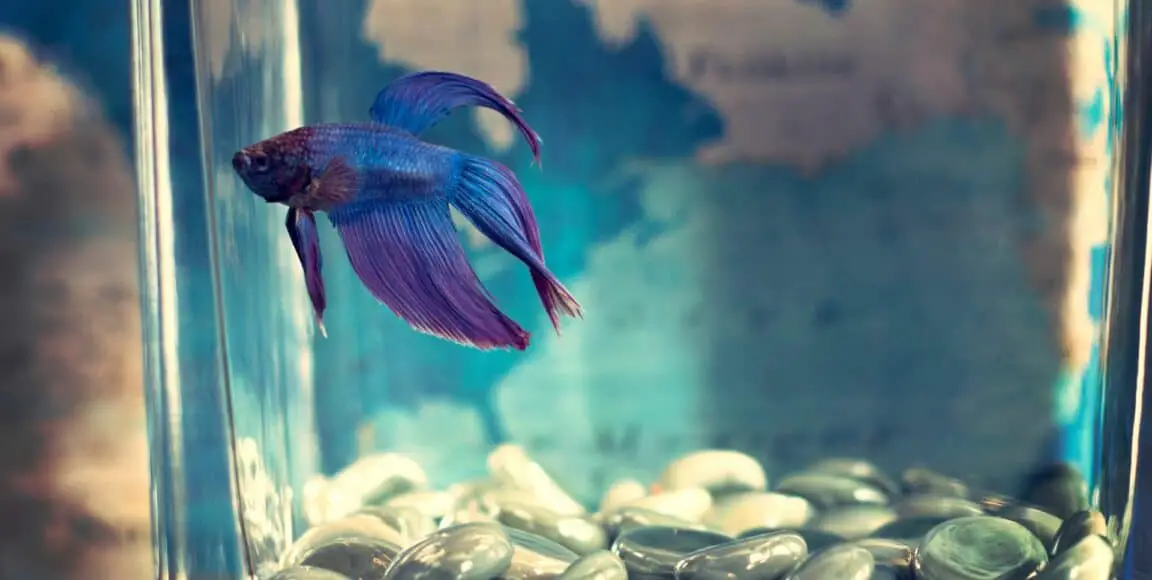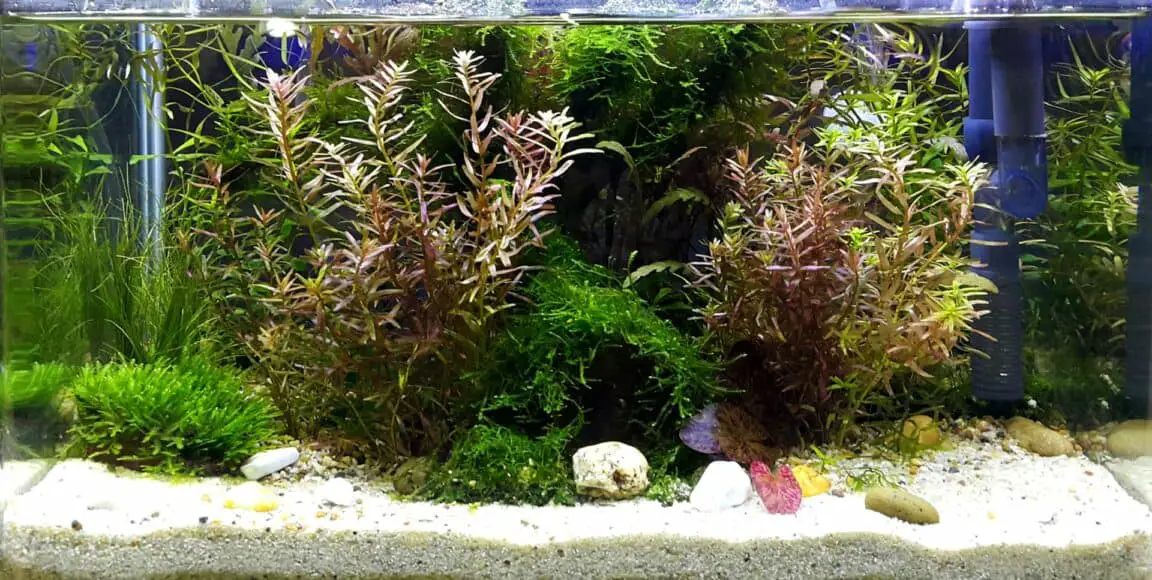Last Updated on December 16, 2022
Recently bought a betta fish?
You may get your bettas in a cup or a plastic bag when you purchase them from a store. But a cup is too small for them to be their permanent home.
Transferring them from one place to another can be a stressful task as well, not only for you but for your beloved pet, especially if you’re doing this for the first time.
Luckily, there are steps you can follow to help you make this process easier.
If your pet betta fish still live in a cup and you’re ready to transfer it to a new tank, this article will show you how to transfer betta fish from cup to tank the best way!
Table of Contents
TL;DR
- It’s not advisable to keep your betta fish in a cup for too long.
- Betta fish can survive in a 2 to 3-gallon tank, but the ideal size is 5 gallons.
- Before transferring your betta fish, ensure the tank is cycled correctly and follows the right water parameters.
- Acclimation is crucial when moving your betta to a new environment.
- You can keep your betta fish alone or with other non-aggressive fish in a community tank.
- You must put your new betta in a quarantine tank for 2-4 weeks before introducing it to its tank mates.
Why is betta fish in a cup?
Usually, store-bought fish are transferred to a cup for you to bring home. But some pet stores keep and display betta fish in cups as long as they’re alive.
Although it’s not a good practice, it’s prevalent.
Why? Because it’s the cheapest way to separate them, as they can get aggressive and territorial. This is especially true for male betta fish.
The size of these cups is typically twice as big as the standard coffee cup. If you think about the size of betta fish, it might feel like it would be enough for them to swim and live.
But here’s the thing.
Fishlab says the best tank size for a single female or male betta fish is 5 gallons.
Now imagine comparing the size of a cup to a 5-gallon one. It becomes obvious how unideal and uncomfortable it is for the bettas to live there.
Before buying a betta, remember that it’s not a starter pet. This fish requires dedication, research, and proper care to have a healthy life.
If you’re really serious about having one, you should prepare and set up the new tank even before you buy your pet fish.
That includes checking if your home has enough space to accommodate its ideal tank size.
If you can’t provide this requirement and can only keep your betta fish in a cup, it’s best not to get one.
Can a betta fish survive and live in a cup?

Yes, it can. But it’s highly discouraged. Living in a cup restricts your betta fish’s movements, making them stressed.
Betta fish are incredibly active and need a minimum of a 2-3 gallon tank to survive. But to make them happy and healthy, getting a 5 to 10-gallon tank is better.
Plus, cups don’t have filtration systems that can help with the water quality, which will be bad for their health in the long run.
Remember that where your betta sleeps is also where they poop and pee. Putting them in a small place is like encouraging them to live in their own waste.
How to transfer betta fish from the cup to the tank?

Transferring betta fish from cup to tank requires patience and steady hands. Do not rush this process. You got to be as careful as possible so as not to stress your new pet.
As mentioned, having all the tools and equipment prepared before buying the betta fish is recommended.
The fish condition is also very crucial in this process. So make sure to examine your betta for any sign of disease or injury before transferring them to their new home.
Step 1: Wash all fish tank objects
Thoroughly wash all the decors, filters, substrate, thermometer, and other objects in its new tank. It’s to ensure that no dirt, debris, or chemicals are left on them.
Step 2: Prepare your betta fish tank
Ensure that you buy the ideal tank size. Afterward, prepare your new tank by cleaning it, putting the decors and substrate, and filling it with dechlorinated tank water.
Step 3: Keep the temperature in check
You shouldn’t skip this part. Transferring your betta fish without checking the temperature first can be fatal.
So make sure to measure the temperature and pH of the water in the cup. Also, check the temperature and pH of the new tank you’ll transfer your betta fish into.
Verify if the temperature on the cup and the new tank is the same. If not, move on to the next step.
Step 4: Introduce the cup to the new tank
Put your fish’s cup inside the new tank for 15-30 minutes to adjust its temperature.
You can also add small amounts of water from the betta tank to the cup. This step allows you to introduce your betta fish to the pH level of the tank.
Step 5: Release your betta fish
Avoid dropping your betta fish inside the cup. Instead, tilt the cup and release your betta to its new home. Make sure to do this step slowly.
Once done with all the steps, check to see the behavior of your betta fish. Monitor any unusual behavior.
For example, check if there’s a sign of color loss, fin clamping, swimming abnormalities, or if the betta fish isn’t eating. It can mean that your fish is sick or stressed.
Also, be careful in adding too many objects inside. To be safe, add one or two decors and plants and see if your betta is okay with it before adding more.
Overcrowding your tank can result in death caused by stress or lack of oxygen.
Can I put betta fish directly into the tank?
This is something you should never do, whether to your new pet or an old one. Immediately transferring your betta fish to a new tank can be fatal.
Your fish needs an adjustment period to its new environment. Make sure you follow all the steps above to safely transfer your fish to the betta tank and make it feel at home.
Why is betta fish acclimation important?

Acclimation is getting your betta fish used to the new environment. It’s crucial in preventing stress and diseases from happening due to abrupt changes.
This includes the new tank water and the conditions of its new home, new plants, and substrate that you will add.
Stress can often result from sudden changes, so this process is important to minimize this effect on your fish. In the end, if done correctly, it will help to ensure that your pet betta enjoys its new space.
But besides acclimating betta fish, you can also do some other things to ensure that they arrive safely in their new home.
When traveling, for instance, try to keep the cup steady and avoid sudden movements that could startle your fish.
Covering the cup with a lid or placing it in a box can also help maintain its temperature.
Betta fish care instructions
The best care you can give your new betta fish is to monitor them as frequently as possible.

As a fish owner, you want to let them explore and keep them happy, but there are certain things to consider that you must keep in mind at all times.
- Keep your pet fish entertained with toys and plants to play with and hide.
- Monitor the proper pH and temperature of its aquarium whenever you can.
- Make sure that your betta fish is well-fed with proper nutrition.
- Keep your new betta fish in its original tank for 2-4 weeks before introducing it to a community tank.
- If you wish to add a new tank mate to your pet betta fish, do your research first.
Betta fish have emotions and can experience depression and frustration with their environment. While some are fine living alone, others may enjoy having a tank mate, lots of plants, some caves, or a bigger aquarium to swim.
Also, bettas require clean and healthy water. Make sure that your betta fish tank has a decent filtration system too.
Being a hands-on pet owner can greatly benefit your betta fish’s overall health. If you always check, you’ll know any little signs that need to be taken care of at once.
Doing so will ensure that your betta fish is living its life happily and healthily with the utmost care you provide.
Can I put my betta fish into a community tank?
A community tank is a type of fish tank that houses multiple fish species.
Transferring your betta fish to a community tank and allowing them to thrive with other kinds of fish is excellent, but only when done right.
However, it’s advised to put it in a separate quarantine tank for a few weeks before introducing it to your community tank. This will help you avoid diseases or parasites the betta fish might have.
Remember that not all species can co-exist with a betta fish. Some fish that aren’t suitable for your community tank include goldfish, puffers, and angelfish.
Doing detailed research on the best fish to add as your betta fish tank mates is a must.
Here’s how you can safely transfer your betta to a community tank:
Step 1 – Put your betta in a plastic cup
This acclimates your betta to the new tank water. It also allows its tank mates to adjust to the presence of your betta. You can leave the betta there for at least 30 minutes.
Step 2 – Distract the other fish by adding food and release your betta
Adding food to the tank gives your betta some time to explore and adjust to its new environment without the other fish getting too close.
Step 3 – Monitor how your fish interacts with the others
It’s important to observe how your betta acts around other fish. If it seems nervous, scared, or aggressive then you might need to consider putting it back in its own tank.
Once everything is settled, your betta fish should be able to co-exist peacefully with its other tankmates.
Must-have tank equipment to help your betta fish survive
Some essential, must-have items include:
Filter
A filter helps to keep the water clean, healthy, and well-oxygenated. It also removes harmful toxins such as ammonia, nitrite, and nitrates.
Heater
Bettas are quite sensitive to temperature changes and need a heater to maintain the ideal conditions for their environment.
A good betta heater should be able to keep the water at an optimal temperature of around 76°F to 85°F (24-29°C).
Substrate
Substrate refers to the material that lines the bottom of your tank. It can be made from anything, such as sand, gravel, etc.
The substrate serves two primary purposes: it makes the aquarium look more aesthetically pleasing and provides an environment for beneficial bacteria to grow and process ammonia and nitrites in the water.
This allows for a more stable and healthy environment for your betta fish.
Decorations
Bettas like plenty of places to hide and explore – decor items such as caves or plants are not only visually appealing but also offer functional and environmental benefits to your new pet.
LED or fluorescent lights
Lighting is an important part of any fish tank. It helps to bring out the colors of your betta and also gives the needed energy to photosynthetically driven plants.
LED lights are an excellent option for betta tanks because they provide bright light without generating too much heat, which can be uncomfortable for your fish.
Frequently Asked Questions
How do I put my betta fish from the cup into the tank?
Always do it slowly and carefully when transferring your betta fish from the cup to its tank. Prepare your tank first, then float the cup in the tank for 10-15 minutes before gently releasing your betta.
Can you put betta fish directly into the tank?
No, it is not recommended to put your betta fish directly into the tank without floating the cup in it first. This process helps acclimate your fish to its new environment, by allowing it to adjust to the water temperature.
What will happen if I let my betta live in a cup?
Bettas can only thrive in the right environment. Hence living in a small cup can cause stress and health issues. The water quality will quickly deteriorate due to waste buildup, resulting in poor water conditions that are unsuitable for your fish.
Conclusion
Now that you know the best ways how to transfer betta fish from cup to tank, it’s time to put them into practice.
Being a good pet fish owner comes with tasks you should be willing to do. So get and set up a new fish tank and prepare it before buying your pet fish.
If you ensure your betta’s health and happiness, you will enjoy each other’s companionship.
A happy and healthy betta fish will indeed thrive and live a long, happy life.
